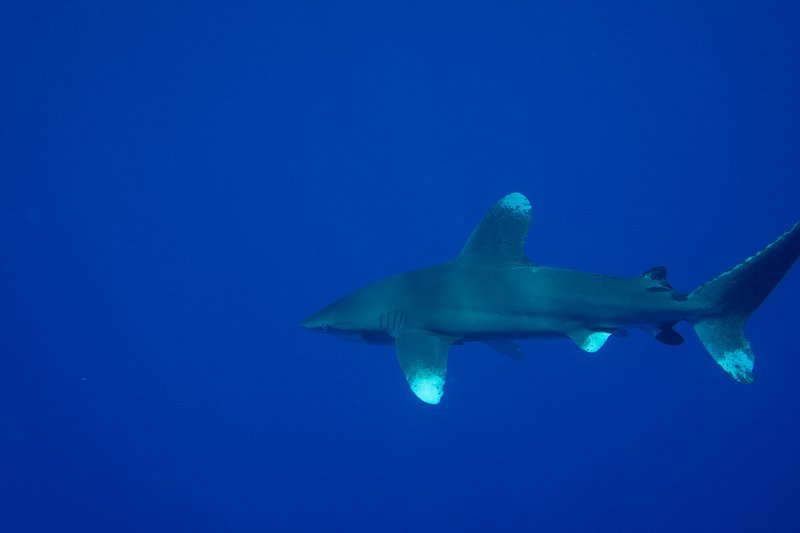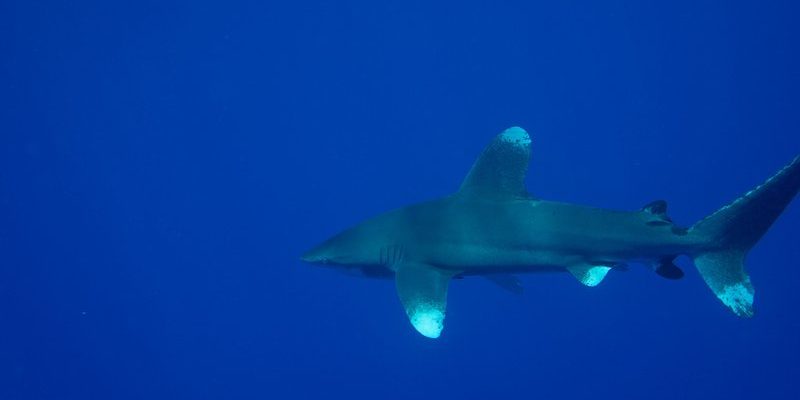
The Oceanic Whitetip Shark, a creature of the deep blue, is one of the ocean’s most intriguing inhabitants. With its long, slender body and characteristic white-tipped fins, this shark has captured the imagination of many marine enthusiasts. If you’ve ever watched a nature documentary, you might remember these sharks gliding gracefully through the water, their sleek forms embodying the essence of oceanic elegance. But there’s so much more to this shark than just its looks.
Imagine a creature that spends its life roaming the vast, open waters, much like a traveler on an endless journey. The Oceanic Whitetip Shark is known for its adventurous spirit and its ability to thrive in environments that others shy away from. Its unique adaptations allow it to explore the depths of the ocean where food is plentiful, making it a vital part of marine ecosystems. Let’s dive deeper into the world of this fascinating shark and uncover what makes it so special.
Physical Characteristics
The Oceanic Whitetip Shark is easily recognizable due to its distinct physical features. It has a streamlined body that can reach lengths of up to 13 feet (4 meters), although most adults average around 8-10 feet (2.5-3 meters). One of its most striking features is its long, slender fins, particularly the white-tipped dorsal fin, which gives the shark its name. These fins are not only beautiful but serve a practical purpose, helping the shark maintain stability and maneuverability in open water.
In terms of coloration, the Oceanic Whitetip Shark typically has a dark brown or gray body, which helps it blend into the ocean depths. This camouflage is essential for both hunting and evading larger predators. The undersides are lighter in color, further aiding in its disguise. It’s a clever adaptation that allows the shark to approach its prey unnoticed.
Another interesting aspect of its anatomy is its eyes. The Oceanic Whitetip Shark has large, well-developed eyes that enable it to see well in low-light conditions, making it an effective hunter during dawn and dusk when many of its prey are active. In essence, the shark’s design is a masterpiece of evolutionary engineering, perfectly suited for its environment.
Habitat and Distribution
Oceanic Whitetip Sharks are found in tropical and subtropical waters around the globe. Their preferred habitats include the open ocean, specifically areas far from the coastline. This preference is a testament to their adaptability; they thrive in depths ranging from the surface down to about 1,000 feet (300 meters), but they are often found near the surface. This behavior is notable because it aligns with their feeding patterns and the presence of prey.
One of the most fascinating aspects of their distribution is their ability to migrate long distances. These sharks are known to travel thousands of miles across oceans, following currents and seasonal changes. This migratory behavior is essential for finding food and breeding grounds, and it showcases the Oceanic Whitetip Shark’s resilience and adaptability in the vast open sea.
However, their habitat is facing threats from human activities. Overfishing and habitat degradation have significantly impacted their populations. Conservation efforts are crucial to maintaining the delicate balance of these marine ecosystems and ensuring the survival of the Oceanic Whitetip Shark.
Diet and Feeding Behavior
The diet of the Oceanic Whitetip Shark is quite varied, as these creatures are opportunistic feeders. They primarily hunt smaller fish, squid, and even crustaceans. Their keen eyesight and agile swimming ability allow them to spot prey from a distance, making them effective hunters. Interestingly, they are also known to scavenge on carcasses, showcasing their versatility in obtaining food.
When it comes to hunting, the Oceanic Whitetip Shark employs a stealthy approach. It often swims slowly and smoothly, using its excellent camouflage to get close to unsuspecting prey. Once within striking distance, it can accelerate quickly to capture its meal. This combination of stealth and speed is what makes them such successful predators in the open ocean.
Moreover, these sharks are social hunters and are often seen swimming in groups. This behavior enhances their hunting success, as they can coordinate attacks on larger schools of fish. It’s fascinating to see how social dynamics play a role in their feeding strategies, making their hunting tactics even more effective.
Reproduction and Lifespan
The reproductive habits of the Oceanic Whitetip Shark are as intriguing as its physical characteristics. They are viviparous, meaning they give birth to live young rather than laying eggs. Female sharks typically have a gestation period of about 9-12 months, after which they give birth to between 1 to 10 pups. The pups are born fully formed and are about 2 feet (60 centimeters) long, ready to fend for themselves in the open ocean.
Interestingly, the Oceanic Whitetip Shark does not provide parental care after birth. Once the pups are released, they are left to navigate the challenges of ocean life alone. This strategy allows them to grow quickly and become independent, adapting to their environment at a young age.
As for their lifespan, Oceanic Whitetip Sharks can live for 10 to 15 years in the wild. However, many face threats from fishing and habitat loss, which can significantly shorten their lives. Understanding their reproductive cycle and lifespan is essential for conservation efforts aimed at protecting this magnificent species.
Conservation Status
Unfortunately, the Oceanic Whitetip Shark is classified as Vulnerable on the IUCN Red List. Their populations have declined sharply due to overfishing, bycatch, and habitat destruction. These sharks are often caught unintentionally in fishing gear designed for other species, which makes their survival increasingly precarious.
Conservationists are working to raise awareness about the importance of this species and push for better fishing regulations. Various marine protected areas have been established to help safeguard their habitats and promote recovery. Supporting sustainable fishing practices is crucial for ensuring that the Oceanic Whitetip Shark can continue to thrive in our oceans.
Efforts are also being made to educate the public about the ecological role of sharks in marine ecosystems. As apex predators, they play a vital role in maintaining the balance of marine life. Protecting the Oceanic Whitetip Shark is not just about saving a single species; it’s about preserving the health of the entire ocean ecosystem.
Interesting Facts
| Size: | Up to 13 feet (4 meters) long |
| Weight: | Up to 350 pounds (160 kg) |
| Habitat: | Tropical and subtropical oceans |
| Diet: | Fish, squid, and crustaceans |
| Lifespan: | 10 to 15 years |
| Reproduction: | Viviparous (live birth) |
Human Interaction
Humans have a complex relationship with the Oceanic Whitetip Shark. While these sharks are often misunderstood as dangerous predators, they are generally not a threat to humans. Most encounters with divers or swimmers end peacefully. However, their reputation has led to increased hunting and fishing pressure, which has contributed to their decline.
In some cultures, the Oceanic Whitetip Shark is revered and often featured in local folklore. Unfortunately, in other areas, they are targeted for their fins, which are used in shark fin soup—a delicacy in some cuisines. This demand has led to unsustainable fishing practices and has pushed these sharks closer to the brink of extinction.
FAQ
What do Oceanic Whitetip Sharks eat?
Oceanic Whitetip Sharks primarily feed on smaller fish, squid, and crustaceans. Their diet is quite varied, and they are known to scavenge on carcasses when necessary. This adaptability in their feeding habits helps them thrive in the vast open ocean where prey abundance can fluctuate.
Are Oceanic Whitetip Sharks dangerous to humans?
Generally, Oceanic Whitetip Sharks are not considered a threat to humans. While they are large and powerful, attacks on humans are extremely rare. Most encounters with these sharks are peaceful, and they tend to avoid divers and swimmers.
How fast can Oceanic Whitetip Sharks swim?
Oceanic Whitetip Sharks are capable of reaching speeds of up to 20 miles per hour (32 kilometers per hour) in short bursts. This speed can help them catch prey and evade potential threats in their environment.
Where do Oceanic Whitetip Sharks live?
These sharks are found in tropical and subtropical oceans worldwide, often in open waters far from the coast. They prefer the upper layers of the ocean but are known to dive deeper in search of prey.
How long do Oceanic Whitetip Sharks live?
In the wild, Oceanic Whitetip Sharks typically live between 10 to 15 years. However, various factors such as overfishing and habitat loss can impact their lifespan and overall population health.
What adaptations help Oceanic Whitetip Sharks survive in the ocean?
Oceanic Whitetip Sharks have several adaptations that enhance their survival, including large, well-developed eyes for low-light hunting and a streamlined body for efficient swimming. Their white-tipped fins also play a role in their hunting strategy by helping them blend into their environment.
What conservation efforts are in place for Oceanic Whitetip Sharks?
Conservation efforts for Oceanic Whitetip Sharks include regulations against overfishing and the establishment of marine protected areas. Education and awareness campaigns aim to change public perceptions about these sharks, highlighting their ecological importance and the need for sustainable practices.
Can you keep Oceanic Whitetip Sharks in aquariums?
Keeping Oceanic Whitetip Sharks in aquariums poses challenges due to their size and space requirements. They need large, open environments to thrive, making them unsuitable for most public aquariums. Conservation efforts focus more on preserving their natural habitats than keeping them in captivity.
Do Oceanic Whitetip Sharks have any predators?
As apex predators in their environment, adult Oceanic Whitetip Sharks have few natural enemies. However, they can be threatened by larger shark species and humans, primarily due to fishing activities. Young pups are more vulnerable to predation from larger fish and other marine life.

